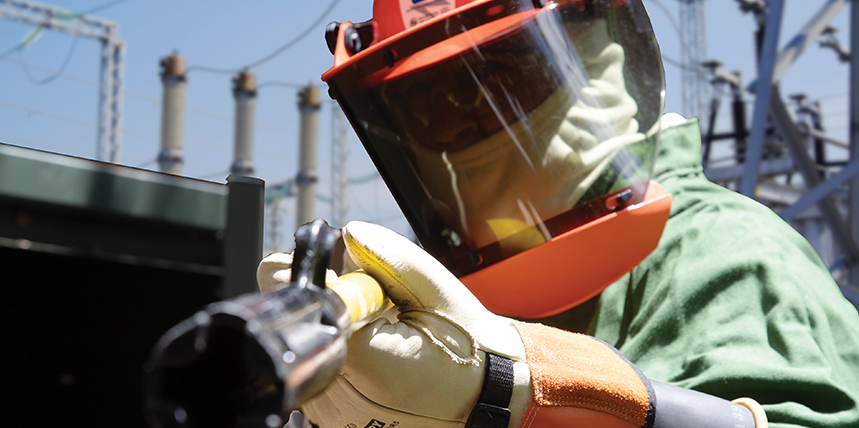Electricity doesn’t take breaks. It doesn’t sleep. It doesn’t care how experienced you are, how close you are to retirement, or how many safety meetings you’ve sat through. It’s always there…silent, invisible, and deadly. And it’s always hunting.
If that sounds dramatic, good. It should. Because electricity kills, and it only takes one mistake. One missed step. One lapse in judgment.
The difference between being the hunter and being the hunted isn’t luck. It’s training, awareness, discipline, and compliance. It’s NFPA 70E® in action, but not just what’s in the 113 pages of the standard, but also in your boots, your gloves, your arc-rated clothing…and in every decision you make on the job. This article is your basic field guide to surviving the hunt.
THE PREDATOR IN THE WIRES
You won’t hear it coming. There’s no growl, no rustle in the grass. Just the hum of equipment, the closing of a contactor, the arc, the flash, the tremendous heat. That’s how electricity strikes – without warning.
According to NFPA 70E Informative Annex K, electrical contact and arc flash incidents represent a serious workplace health and safety issue. They rank among the top causes of occupational fatalities in industrial and commercial environments. The victims? Often skilled, most certainly dedicated, but usually caught off guard. Caught being hunted.
What’s missing in too many cases is the shift in mindset. Here’s a thought: You must stop walking into electrical environments like a bystander and start entering like a hunter —aware, cautious, deliberate.
Electrical safety culture is vitally important, and electricity doesn’t care about your experience, only your preparation. A strong safety culture is your first and best defense.
Many of the embedded sections in NFPA 70E represent an electrical safety culture theme. From the personal side, go down into the individual performance side of things, where risk assessment and human performance are addressed in Section 110.3(H)(2) Human Error. This provides a risk assessment procedure to ensure human error is considered. It also points to Informative Annex Q, Human Performance and Workplace Electrical Safety, and specifically check out Section Q.8, Workplace Culture for further information. With electrical hazards, personal responsibility for workers, managers, and the organization, in conjunction with appropriate preparation, is everything.
KNOW THE TERRAIN: UNDERSTAND YOUR ELECTRICAL ENVIRONMENT
A good hunter knows the land — every dip, every shadow, every path. In our world, that means knowing your surroundings, your equipment, and what’s energized and when.
Situational awareness is everything. Never assume a circuit is de-energized. Never trust labels that haven’t been verified. Open panels, look-alike equipment, temporary wiring and backfeed, missing covers — these can all be your ambush points.
- Article 100 Definitions defines key terms, including “qualified person,” as someone who has demonstrated skills and knowledge related to the construction and operation of electrical equipment and installations, along with safety training to identify and mitigate hazards. This sets the foundation for why understanding equipment is essential for safety.
- Article 110.4 Training Requirements outlines the mandatory training for qualified persons, which must include understanding electrical hazards, precautionary techniques, proper use of PPE, insulating tools, and test equipment, as well as skills to distinguish exposed live parts, determine nominal voltages, and assess equipment-specific risks. It emphasizes that qualification is task- and equipment-specific.
- Chapter 2 Safety-Related Maintenance Requirements provides guidance on maintaining electrical equipment to prevent failures and other hazards. Those of us in the electrical maintenance arena should have a complete understanding of Chapter 2, as it requires equipment to be maintained per manufacturers’ instructions or industry consensus standards such as NETA’s testing standard, ANSI/NETA MTS–2023, Standard for Maintenance Testing Specifications for Electrical Power Equipment and Systems.
ARM YOURSELF: PPE IS YOUR BODY ARMOR
No hunter walks into danger unprotected. With what we do, that means wearing the proper PPE at all times — every time! Arc-rated clothing, voltage-rated gloves, face shields, safety glasses, and hearing protection: Every piece of PPE is there to absorb what would otherwise hit your body in the event of an electrical incident.
- Article 130.4 Shock Risk Assessment requires assessing shock hazards based on nominal voltage, approach boundaries using resources like Table 130.4(E)(a), and taking necessary protective measures. Understanding the equipment’s configuration and possible exposure points helps you determine safe working distances and the required PPE.
- Article 130.5 Arc Flash Risk Assessment requires you to evaluate arc flash hazards through analyzing incident energy or using the PPE category method available in Tables 130.7(C)(15)(a) and 130.7(C)(15)(b), which relies on your knowledge of equipment parameters such as available fault current, clearing times, and working distances. Understanding the equipment’s design and condition is critical for accurate assessment and arc flash hazard labeling.
There are many real-life stories about electrical workers who lived to tell the tale because they wore the right gear. Unfortunately, just as many were seriously injured because they skipped this aspect of the hunt “just this once.”
TRAIN LIKE YOUR LIFE DEPENDS ON IT (BECAUSE IT DOES)
Instinct doesn’t come from guessing. It comes from training. From repetition. From repetition. From repetition. From knowing your tools, your risks, your equipment, and your escape plan. (Read: being qualified!)
- Article 100 defines a Qualified Person as someone not just familiar with the work but trained to recognize and avoid the electrical hazards involved.
- Per Article 110.4 Training Requirements, retraining is required at least every three years, or whenever the job changes, the hazards change, or a safety lapse occurs.
- Section 110.4(A)(1) Elements of a Risk Assessment Procedure states, in part: “persons shall also be familiar with the proper use of applicable precautionary techniques, electrical policies, procedures, PPE, insulating materials, shielding materials, and insulated tools and equipment.”
TRACK THE HAZARDS: PLANNING, RISK ASSESSMENTS, AND CONTROL
Never go in blind. Every job should start with a job safety plan and job briefing as required by Section 110.3(I)(1) Job Safety Planning and Section 110.3(I)(2) Job Briefing. You need to identify:
- What could go wrong?
- What’s the likelihood?
- What are the consequences?
- What will we do to eliminate or control the risk?
Here’s a good practice to implement: Use the Hierarchy of Risk Control Methods found in 110.3(H)(3) Hierarchy of Risk Control Methods. Elimination is best. PPE is the last line of defense. Don’t rely on the armor (PPE) if you can just neutralize the threat altogether.
THE HUNT NEVER ENDS
This is a daily battle. Every task is a new opportunity to do it right or a new chance to make a mistake. Don’t let familiarity breed complacency. Respect electricity. Fear it a little. And hunt for it every day.
Check your PPE. Follow procedures. Do the training. Complete the job plan. Think. Ask. Stop when something doesn’t feel right. Because when it comes to electricity, there’s no rewind button. Only the choice to be ready…or not.
BACK AT CAMP
In summary, we’ll leave you with this: You don’t rise to the level of the hazard; you fall to the level of your preparation. So hunt hard, hunt smart, and never let electricity hunt you!
You’ll be glad you did.
And hey, Bubba, turn it off and…Test Before Touch.

Ron Widup is the Vice Chairman, Board of Directors, and Senior Advisor, Technical Services for Shermco Industries and has been with Shermco since 1983. He is a member of the NETA Board of Directors and Standards Review Council; a Principal member of the Technical Committee on Standard for Electrical Safety in the Workplace (NFPA 70E); Principal member of the National Electrical Code (NFPA 70) Code Panel 11; Principal member and Chairman of the Technical Committee on Standard for Competency of Third-Party Evaluation Bodies (NFPA 790); Principal member and Chairman of the Technical Committee on Recommended Practice and Procedures for Unlabeled Electrical Equipment Evaluation (NFPA 791); a Principal member of the Technical Committee Standard for Electrical Equipment Maintenance (NFPA 70B); and Chair of IEEE Std. P902 (Yellow Book) Recommended Practice for Maintenance and Operational Safety of Electrical Power Distribution Systems in Industrial and Commercial Facilities.He is Chairman of the Texas State Technical College System (TSTC) Board of Regents, a NETA Certified Level 4 Senior Test Technician, State of Texas Journeyman Electrician, a Senior Member of the IEEE Standards Association, and an NFPA Certified Electrical Safety Compliance Professional (CESCP).
